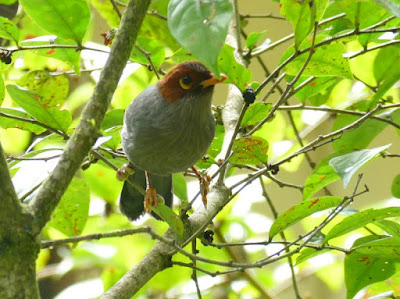It's been a while now since I did my last posting in the ongoing but irregular series on colours in nature; that one was the third in a series of orange in animals, a topic that gave me some angst, in that I found it very difficult to say just where orange ends and rufous-ginger-chestnut colours begin. I doubtless included some examples that you don't agree were really orange, and I'm not going to argue; in addition to our propensity to define colours differently from each other, the limits of 'orange' do seem to be very blurry indeed.
 |
| Chestnut Teals Anas castanea, south coast New South Wales, females on the left, males on the right. The rich rusty colours on the males are the ones I'm talking about today. |
Not that it really matters of course; the ultimate purpose of these postings, in addition to saying a little about how colours come about, is to revel in a parade of glorious animals (not many flowers in this colour category, though I may look into plants again in this context in the future). Once I started looking at potential examples of gingery-coloured animals, I realised that the options are very plentiful indeed. Indeed, I reckon I've got material for four postings; as it happens I'm going back to Malaysian Borneo next week, so I'll prepare another two postings on this topic to tide us over until I return in late May.
While perusing the possibilities, I realised that we use different terminology when talking about rusty birds and the same-coloured mammals. We use 'red' fairly carelessly in mammals (think of Red Kangaroos, Foxes and Deer for instance, not to mention 'red'-haired humans) but not nearly so much in birds. In fact for today's posting I'm going to concentrate solely on birds with Chestnut or Rufous in their name - and there are very many indeed.
The chemicals that make the Chestnut Teals chestnut, and red-headed people 'red', are a class of melanins called phaeomelanins (or pheomelanins). Melanins are produced in the body, unlike some other pigments we've discussed in the past which can only be obtained in food. Combinations of various phaeomelanins and brown or black eumelanins give rise to all the shades we'll be looking at over the next few weeks, plus others. And now, let's just enjoy some Chestnut and Rufous birds.
 |
| Chestnut-quilled Rock-Pigeon Petrophassa rufipennis, Kakadu National Park. A little more about this lovely sandstone endemic here; the chestnut quills are just visible. |
 |
| Chestnut-breasted Mannikin Lonchura castaneothorax, Darwin. |
 |
| Chestnut Munia Lonchura atricapilla, a close relative of the previous species, though 'munia' is not much used in Australia. |
 |
| Chestnut-bellied Starling Lamprotornis pulcher, Waza NP, northern Cameroon. This attractive starling has a huge range across arid sub-Saharan Africa, from the Atlantic to the Red Sea. |
 |
| Chestnut-breasted Coronet Boissonneaua matthewsii, Guango Lodge, northern Peru. A gorgeously rich hummingbird from the cloud forests of the northern Andes. |
 |
| Chestnut-crowned Antpitta Grallaria ruficapilla, Paz de las Aves, Ecuador. Without the patient habituation to being fed worms by the Paz brothers, such a sighting would be almost impossible. |
 |
| Chestnut-hooded Laughing-thrush Garrulax treacheri, Kinabalu NP, Sabah. Not a thrush at all, but an Old World babbler. |
Which brings us from Chestnuts to Rufouses - and I suspect that if I jumbled them up and didn't tell you which was which, you'd have some real trouble allocating them correctly!
 |
| Rufous Treecreeper Climacteris rufus, Porongorups NP, Western Australia. The Australian treecreepers are a very ancient passerine lineage. |
 |
| Rufous Owl Ninox rufa, Yungaburra, tropical Queensland. |
 |
| Rufous Fantail Rhipidura rufifrons, Monga NP, New South Wales. A very active and attractive flycatcher of wet forests of eastern Australia and beyond. |
 |
| Rufous Whistler male Pachycephala rufiventris, near Canberra. A rather more washed-out rufous than most we've met so far. |
 |
| Rufous-banded Honeyeater Conopophila albogularis, Kakadu NP, Northern Territory. A small tropical honeyeater also found in New Guinea. |
 |
| Rufous Songlark Megalurus mathewsi, near Georgetown, north Queensland. Not quite as silly as it sounds - the rump is rufous, just visible here. |
 |
| Rufous Antpitta Grallaria rufula, Yanacocha Reserve, north-west of Quito, Ecuador. A shy resident of high altitude cloud forests. |
 |
| Rufous Motmot Baryphthengus martii, Arasha Lodge, Mindo Valley, Ecuador. |
 |
| Rufous Hornero Furnarius rufus, Buenos Aires, Argentina. A common ground-dwelling ovenbird in Buenos Aires parks. |
 |
| Rufous-bellied Thrush Turdus rufiventris, another common Buenos Aires bird. |
 |
| Rufous-tailed Hummingbird Amazilia tzacatl, Alanbi Lodge, Ecuador. |
 |
| Rufous-tailed Plantcutter Phytotoma rara, Chilean Patagonia. For now at least regarded as a cotinga. |
 |
| Rufous-crested Coquette Lophornis delattrei, Waqanki Lodge, north-eastern Peru. Even by hummingbird standards, this one is over the top! |
And with that I think we can leave it for today; there were others I could have featured and of course there are many rufous/chestut/etc birds which aren't called that; we'll visit some of them in due course, but I think that next time we'll look at some rusty-coloured mammals.
BACK ON SATURDAY 14 MAY




No comments:
Post a Comment